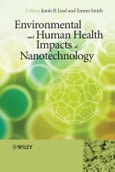Topics covered include:
- The properties, preparation and applications of nanomaterials
- Characterization and analysis of manufactured nanoparticles
- The fate and behaviour of nanomaterials in aquatic, terrestrial and atmospheric environments
- Ecotoxicology and human toxicology of manufactured nanoparticles
- Occupational health and exposure of nanomaterials
- Risk assessment and global regulatory and policy responses
Understanding the behaviour and impacts of nanotechnology in the environment and in human health is a daunting task and many questions remain to be answered. Environmental and Human Health Impacts of Nanotechnology will serve as a valuable resource for academic researchers in nanoscience and nanotechnology, environmental science, materials science and biology, as well as for scientists in industry, regulators and policy makers.
Table of Contents
PrefaceBiographies
Contributors
Chapter 1 - Overview of Nanoscience in the Environment
M. Baalousha and J.R. Lead
1.1 Introduction
1.2 History
1.3 Definitions
1.4 Investment and International Efforts
1.5 Development: Four Anticipated Generations
1.6 Applications of Nanotechnology
1.7 Potential Benefits of Nanotechnology
1.8 Potential Adverse Effects of Nanomaterials
1.9 Classification
1.10 Sources of Nanomaterials in the Environment
1.11 Properties of Nanomaterials
1.12 Nanomaterial Structure–Toxicity Relationship
1.13 Environmental Fate and Behaviour of Nanomaterials
1.14 Potential for Human Exposure
1.15 Detection and Characterization of Nanomaterials
1.16 Issues to be Addressed
1.17 Conclusion
1.18 References
Chapter 2 - Nanomaterials: Properties, Preparation and Applications
Paul Christian
2.1 Overview
2.2 Introduction
2.3 Nanoparticle Architecture
2.4 Particle Properties
2.5 Nanoparticle Preparation
2.6 Applications of Nanoparticles and Nanotechnology
2.7 Implication for Environmental Issues
2.8 Conclusions
2.9 References
Chapter 3 - Size/Shape–Property Relationships of Non-Carbonaceous Inorganic Nanoparticles and Their Environmental Implications
Deborah M. Aruguete, Juan Liu and Michael F. Hochella, Jr
3.1 Introduction
3.2 Inorganic Nanoparticle Anatomy
3.3 Redox Chemistry of Nanoparticles
3.4 Size Effects in Nanoparticle Sorption Processes
3.5 Nanoparticle Fate: Dissolution and Solid State Cation Movement
3.6 Effect of Nanoparticle Aggregation on Physical and Chemical Properties
3.7 Environmental Implications: General Discussion, Recommendations and Outlook
3.8 References
Chapter 4 - Natural Colloids and Nanoparticles in Aquatic and Terrestrial Environments
M. Baalousha, J.R. Lead and F.v.d. Kammer and Th. Hofmann
4.1 Introduction
4.2 Definition
4.3 Major Types of Environmental Colloids
4.4 Intrinsic Properties of Environmental Colloidal Particles
4.5 Interaction Forces Between Colloidal Particles
4.6 Fate and Behaviour of Colloids in Aquatic Systems
4.7 Fate and Behaviour of Colloids and Nanoparticles in Porous Media
4.8 Conclusion
4.9 References
Chapter 5 - Atmospheric Nanoparticles
Aurélie Charron and Roy M. Harrison
5.1 Introduction
5.2 Sources of Atmospheric Nanoparticles
5.3 Chemical Composition of Atmospheric Nanoparticles
5.4 Fate and Behaviour of Atmospheric Nanoparticles
5.5 Atmospheric Concentrations
5.6 Measurement Methods for Atmospheric Nanoparticles
5.7 Conclusions
5.8 References
Chapter 6 - Analysis and Characterization of Manufactured Nanoparticles in Aquatic Environments
Martin Hassellöv and Ralf Kaegi
6.1 Introduction
6.2 Nanoparticle Analysis and Characterization Methods
6.3 Analytical Test Strategy in NP Exposure Assessment
6.4 Conclusions
6.5 Acknowledgements
6.6 References
7. Ecotoxicology of Manufactured Nanoparticles
Simon C. Apte, Nicola J. Rogers and Graeme E. Batley
7.1 Introduction
7.2 Physico-Chemical Transformation of Nanoparticles
7.3 Mechanisms of Nanoparticle Toxicity in the Environment
7.4 Development of Valid/Realistic Toxicity Testing Protocols
7.5 Review of Ecotoxicity Studies
7.6 General Conclusions and Future Directions
7.7 References
8. Exposure to Nanoparticles
Robert J. Aitken, Karen S. Galea, C. Lang Tran and John W. Cherrie
8.1 Introduction
8.2 Physical Characteristics and Properties of Nanoparticles
8.3 Nanoparticle Exposure
8.4 Control of Exposure
8.5 Discussion
8.6 References
9. Human Toxicology and Effects of Nanoparticles
Vicki Stone, Martin Clift and Helinor Johnston
9.1 Introduction
9.2 Ultrafine Particle Toxicology
9.3 Engineered Nanoparticles
9.4 Relating Physico-Chemical Properties to Toxicity; Structure: Activity Relationships
9.5 Suggestions for Future Study Designs
9.6 Conclusions
9.7 Abbreviations
9.8 References
10. Risk Assessment of Manufactured Nanomaterials
Sophie A. Rocks, Simon J. Pollard, Robert A. Dorey, Paul T. C. Harrison, Len S. Levy, Richard D. Handy, John F. Garrod and Richard Owen
10.1 Introduction
10.2 Risk Assessment Process
10.3 Nanomaterials – Issues for Risk Assessment
10.4 Assembling Evidence for Safety and Intervention
10.5 International Case Studies
10.6 Data Gaps in Risk Assessment of Nanomaterials
10.7 Summary
10.8 References








